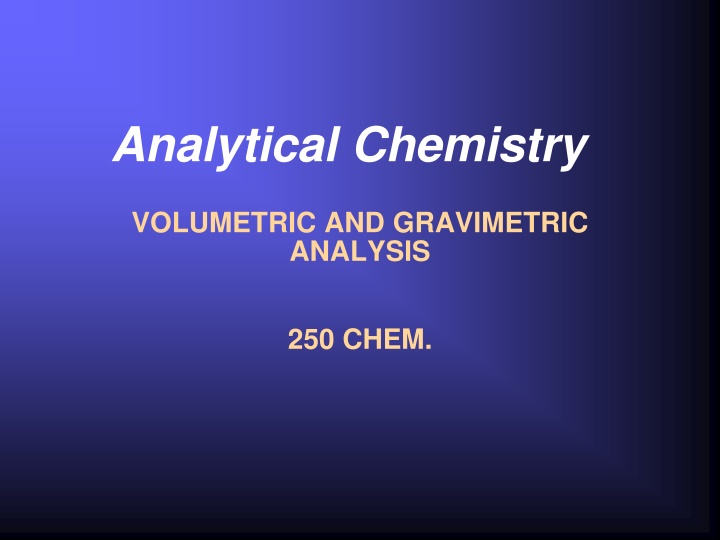
Introduction to Analytical Chemistry: Methods, Applications, and Importance
In the field of analytical chemistry, various methods such as volumetric and gravimetric analysis are utilized to separate, identify, and quantify chemical components in natural and artificial materials. This comprehensive discipline covers qualitative and quantitative analysis techniques, classical and instrumental methods, and various areas of application like clinical, pharmaceutical, environmental, forensic, and industrial quality control. Analytical chemistry plays a crucial role in understanding chemical properties and ensuring quality in diverse industries.
Download Presentation

Please find below an Image/Link to download the presentation.
The content on the website is provided AS IS for your information and personal use only. It may not be sold, licensed, or shared on other websites without obtaining consent from the author. If you encounter any issues during the download, it is possible that the publisher has removed the file from their server.
You are allowed to download the files provided on this website for personal or commercial use, subject to the condition that they are used lawfully. All files are the property of their respective owners.
The content on the website is provided AS IS for your information and personal use only. It may not be sold, licensed, or shared on other websites without obtaining consent from the author.
E N D
Presentation Transcript
Analytical Chemistry VOLUMETRIC AND GRAVIMETRIC ANALYSIS 250 CHEM.
King Saud university Chemistry department 250 Chem. Volumetric and Gravimetric Analysis 5(3+1+1) Instructor :Dr. wedad Alonazi Office No. : 188Building 5 Phone. : Email : walonazi@ksu.edu.sa Class time: 10.00-11. Place:5/21 Text book:. : Analytical Chemistry by G.D. Christian , Jone Wiley and Sons , New York , last edition . Week 1,2,3 4,5,6,7,8,9 Topice Solutions and concentrations Chemical Equilibrium: Dissociation constant in acid-base reaction, Solubility product in perception reaction, Formation constant in complexes, equilibrium constant in redox reaction) Volumetric analysis (titrations) (Neutralization, Perception, Complexiometric, redox) Gravimetric analysis Review and problems 10,11,12,13 14,15 16
Schedule of Assessment Tasks for Students During the Semester Assessment Assessment task Date Proportion of final assessment 1 Midterm exam I 10 13\6\1439 2 3 Midterm exam II 5\7\1439 10 Practical exam I 15 4 Practical exam II - 15 5 Quizzes home works 10 6 Final exam 40
What is Analytical Chemistry???? Analytical chemistry is the study of the separation, identification, and quantification of the chemical components of natural and artificial materials Branches of analytical chemistry Qualitative Quantitative gives an indication of the identity of the chemical species in the sample determines the amount of certain components in the substance Qualitative: recognized by color, boiling point, solubility, taste
Classification of Quantitative Methods of Analysis Classical methods Instrumental Method use an instrumental technique to assay the amount of sample Gravimetric Method: mass is measured. Volumetric Method: volume is measured Spectrophotometric Interaction of light and matter Electro analytical Measurement of electrical property
Several different areas of analytical chemistry: Clinical analysis Pharmaceutical Environmental analysis Forensic analysis Industrial quality control Bioanalytical chemistry
Analytical Methodology 1. Understanding and defining the problem 2. Select a method A-sample type B-size of sample C-samples preparation needed D-sensitivity and selectivity E-accuracy and precision needed F-tools/instrument available g-Cost and speed 3- obtain representative sample A-sample type / homogeneity/size 4- preparing the sample for analysis 5-Perform the measurement 6-Calculate the result and report



